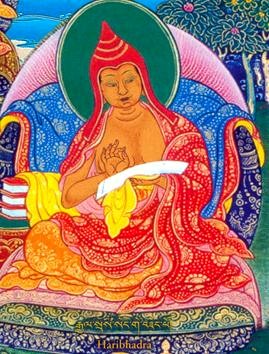Eight topics: Difference between revisions
Jump to navigation
Jump to search
mNo edit summary |
|||
| Line 3: | Line 3: | ||
</noinclude> | </noinclude> | ||
==The Eight Topics== | ==The Eight Topics== | ||
#[[knowledge of all aspects]], [[omniscience]] (Skt. ''Sarvākārajñatā''; Tib. རྣམ་ཀུན་མཁྱེན་ཉིད་, ''nam kun khyen nyi'' or [[རྣམ་མཁྱེན་]], "namkhyen") | #[[knowledge of all aspects]], [[omniscience]] (Skt. ''Sarvākārajñatā''; Tib. རྣམ་ཀུན་མཁྱེན་ཉིད་, ''nam kun khyen nyi'' or [[རྣམ་མཁྱེན་]], "namkhyen") | ||
#[[path-knowledge]] (Skt. ''Mārgākārajñatā''; Tib. ལམ་ཤེས་ཉིད་, ''lamshe nyi'' or [[ལམ་ཤེས་]], ''lamshe'') | #[[path-knowledge]] (Skt. ''Mārgākārajñatā''; Tib. ལམ་ཤེས་ཉིད་, ''lamshe nyi'' or [[ལམ་ཤེས་]], ''lamshe'') | ||
#[[base-knowledge]], knowledge of the bases, knowledge of the foundation (Skt. ''vastujñāna''; Tib. [[གཞི་ཤེས་]], ''zhishe'') but also all-knowledge (Skt. ''Sarvajñatā''; Tib. ཐམས་ཅད་ཤེས་པ་ཉིད་, ''tamche shepa nyi'') | #[[base-knowledge]], knowledge of the bases, knowledge of the foundation (Skt. ''vastujñāna''; Tib. [[གཞི་ཤེས་]], ''zhishe'') but also all-knowledge (Skt. ''Sarvajñatā''; Tib. ཐམས་ཅད་ཤེས་པ་ཉིད་, ''tamche shepa nyi'') | ||
#[[complete application of all aspects]], application of the realization of all aspects (Skt. ''Sarvākārābhisambodha''; Tib. རྣམ་ཀུན་མངོན་རྫོགས་རྟོགས་པ་ but also [[རྣམ་རྫོགས་སྦྱོར་བ་]], ''namdzog jorwa'') | #[[complete application of all aspects]], application of the realization of all aspects (Skt. ''Sarvākārābhisambodha''; Tib. རྣམ་ཀུན་མངོན་རྫོགས་རྟོགས་པ་ but also [[རྣམ་རྫོགས་སྦྱོར་བ་]], ''namdzog jorwa'') | ||
#[[culminating application]], application when reaching the peak (Skt. ''Murdhābhisamaya''; Tib. [[རྩེ་མོར་སྦྱོར་བ་]], | #[[culminating application]], application when reaching the peak (Skt. ''Murdhābhisamaya''; Tib. [[རྩེ་མོར་སྦྱོར་བ་]], ''tsemor jorwa'') | ||
#[[progressive application]], gradual training, gradual application of the bodhisattva path (Skt. ''Anupurvābhisamaya''; Tib. [[མཐར་གྱིས་པའི་སྦྱོར་བ་]], ''thar gyi jorwa'') | #[[progressive application]], gradual training, gradual application of the bodhisattva path (Skt. ''Anupurvābhisamaya''; Tib. [[མཐར་གྱིས་པའི་སྦྱོར་བ་]], ''thar gyi jorwa'') | ||
#[[instantaneous application]], momentary training (Skt. ''Ekakṣanābhisamaya''; Tib. [[སྐད་ཅིག་མའི་སྦྱོར་བ་]], ''kechigme jorwa'')<br> | #[[instantaneous application]], momentary training (Skt. ''Ekakṣanābhisamaya''; Tib. [[སྐད་ཅིག་མའི་སྦྱོར་བ་]], ''kechigme jorwa'')<br> | ||
#[[dharmakaya]] (Skt. ''dharmakāya'' but also ''Dharmakāyābhisambodha | #[[dharmakaya]] (Skt. ''dharmakāya'' but also ''Dharmakāyābhisambodha''; Tib. [[ཆོས་སྐུ་]], ''chö ku'', Wyl. ''chos sku'') | ||
<noinclude> | <noinclude> | ||
==Internal Links== | ==Internal Links== | ||
Latest revision as of 13:39, 9 October 2023

Eight topics (Skt. aṣṭa padārtha; Tib. དངོས་པོ་བརྒྱད་, Wyl. dngos po brgyad) or the eight clear realizations (Tib. མངོན་རྟོགས་བརྒྱད་, Wyl. mngon rtogs brgyad) — the Abhisamayalankara is divided into eight topics:
The Eight Topics
- knowledge of all aspects, omniscience (Skt. Sarvākārajñatā; Tib. རྣམ་ཀུན་མཁྱེན་ཉིད་, nam kun khyen nyi or རྣམ་མཁྱེན་, "namkhyen")
- path-knowledge (Skt. Mārgākārajñatā; Tib. ལམ་ཤེས་ཉིད་, lamshe nyi or ལམ་ཤེས་, lamshe)
- base-knowledge, knowledge of the bases, knowledge of the foundation (Skt. vastujñāna; Tib. གཞི་ཤེས་, zhishe) but also all-knowledge (Skt. Sarvajñatā; Tib. ཐམས་ཅད་ཤེས་པ་ཉིད་, tamche shepa nyi)
- complete application of all aspects, application of the realization of all aspects (Skt. Sarvākārābhisambodha; Tib. རྣམ་ཀུན་མངོན་རྫོགས་རྟོགས་པ་ but also རྣམ་རྫོགས་སྦྱོར་བ་, namdzog jorwa)
- culminating application, application when reaching the peak (Skt. Murdhābhisamaya; Tib. རྩེ་མོར་སྦྱོར་བ་, tsemor jorwa)
- progressive application, gradual training, gradual application of the bodhisattva path (Skt. Anupurvābhisamaya; Tib. མཐར་གྱིས་པའི་སྦྱོར་བ་, thar gyi jorwa)
- instantaneous application, momentary training (Skt. Ekakṣanābhisamaya; Tib. སྐད་ཅིག་མའི་སྦྱོར་བ་, kechigme jorwa)
- dharmakaya (Skt. dharmakāya but also Dharmakāyābhisambodha; Tib. ཆོས་སྐུ་, chö ku, Wyl. chos sku)
Internal Links
- Seventy points, a subdivision of the eight topics.